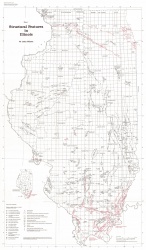Sangamon Arch
Location
West-central Illinois (plate 1 inset)

References
Whiting and Stevenson 1965, Collinson 1967, Peppers and Damberger 1969, Atherton 1971, Calvert 1974, Stevenson and Calvert 1975, Collinson and Atherton 1975, Stevenson et al. 1981, Treworgy et al. 1994
Description
As proposed by Whiting and Stevenson (1965) and accepted by most geologists, the Sangamon Arch was a broad subaerially exposed rise that existed during the Devonian Period. It extended southwestward from central Illinois toward Pike County and possibly beyond into Missouri (fig. 65).
The Sangamon Arch has no present structural expression. It was primarily a Middle Devonian feature. Its extent during the Early Devonian Epoch cannot be assessed because strata of that age are absent from the region. Silurian rocks have been partially eroded along the crest of the arch and are unconformably overlain by Middle Devonian beds (fig. 65). Vugs and fissures that extend 90 feet (27 m) or more below the top of the Silurian are filled with Devonian green clay, clean white sand, and limestone fragments (Whiting and Stevenson 1965). A basal Devonian lag gravel of chert clasts commonly overlies the corroded Silurian surface. The arch apparently formed a barrier between two separate basins of deposition where different facies accumulated. Southeast of the arch are open-marine limestone and dolomite of the Grand Tower and Lingle Formations (fig. 65). The Cedar Valley and Wapsipinicon Formations northwest of the arch contain evaporites, indicating restricted circulation, near the basin center in Iowa and shallow water oolitic limestone and sandstone on the flank of the Sangamon Arch. Coal containing fragments of land plants occurs on the north flank of the arch in De Witt and McLean Counties, Illinois (Peppers and Damberger 1969). Older Middle Devonian units pinch out on the flanks of the arch and are progressively overlapped by younger Middle Devonian units. The Upper Devonian New Albany Group was deposited entirely across the Sangamon Arch, although it is thinner there than elsewhere. The thinning axis ("central thin" between southern and western depocenters [Cluff et al. 1981]) of the New Albany is south of the crest of the Middle Devonian Sangamon Arch.
Most researchers have interpreted the relationships described above as evidence that the Sangamon Arch was a short-lived structural high that was subaerially exposed at the beginning of the Middle Devonian Epoch and gradually became submerged. Calvert (1974) doubted the existence of a structural arch and proposed instead that Silurian and Devonian rocks were eroded in a southwest-trending drainage basin. Calvert won no public supporters (see Stevenson and Calvert 1975 for argument and rebuttal).
Figure(s)
|

